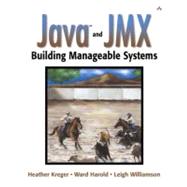
Heather Kreger was the original JMX evangelist at IBM. A founding member of the JMX expert group, she personally contributed ModelMBeans to the JMX specification and is currently applying management to Web services technologies.
Ward Harold is the lead architect for Tivoli's implementation of JMX, TMX4J. He is a member of the current JMX expert group.
Leigh Williamson led the design and implementation of the WebSphere Version 5 new administrative architecture.
I. JMX INTRODUCTION.
1. Management Concepts.II. JMX DETAILS.
III. APPLICATION OF JMX.
The New copy of this book will include any supplemental materials advertised. Please check the title of the book to determine if it should include any access cards, study guides, lab manuals, CDs, etc.
The Used, Rental and eBook copies of this book are not guaranteed to include any supplemental materials. Typically, only the book itself is included. This is true even if the title states it includes any access cards, study guides, lab manuals, CDs, etc.